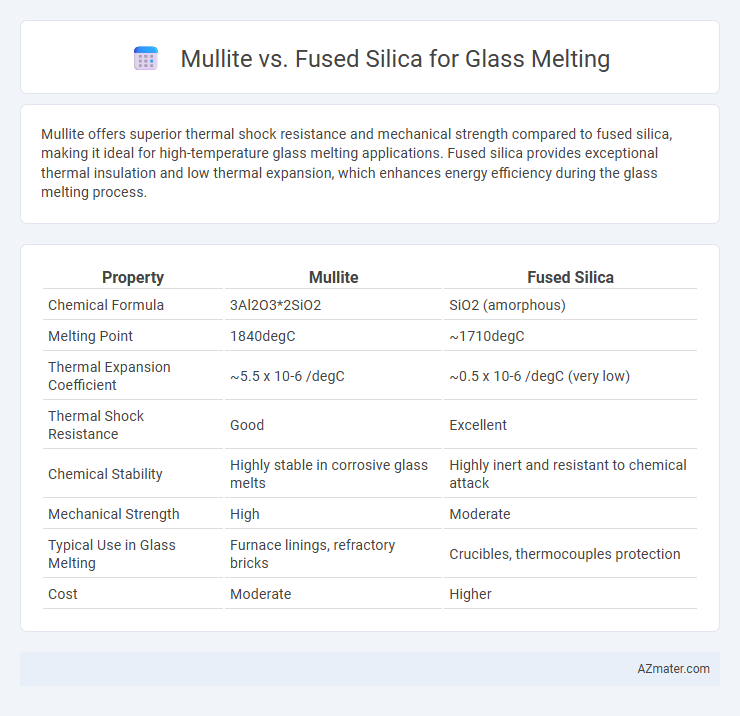Mullite offers superior thermal shock resistance and mechanical strength compared to fused silica, making it ideal for high-temperature glass melting applications. Fused silica provides exceptional thermal insulation and low thermal expansion, which enhances energy efficiency during the glass melting process.
Table of Comparison
| Property | Mullite | Fused Silica |
|---|---|---|
| Chemical Formula | 3Al2O3*2SiO2 | SiO2 (amorphous) |
| Melting Point | 1840degC | ~1710degC |
| Thermal Expansion Coefficient | ~5.5 x 10-6 /degC | ~0.5 x 10-6 /degC (very low) |
| Thermal Shock Resistance | Good | Excellent |
| Chemical Stability | Highly stable in corrosive glass melts | Highly inert and resistant to chemical attack |
| Mechanical Strength | High | Moderate |
| Typical Use in Glass Melting | Furnace linings, refractory bricks | Crucibles, thermocouples protection |
| Cost | Moderate | Higher |
Introduction to Mullite and Fused Silica
Mullite, an aluminosilicate ceramic with high thermal stability and resistance to thermal shock, is commonly used as a refractory material in glass melting furnaces. Fused silica, composed almost entirely of silicon dioxide, offers exceptional thermal insulation and low thermal expansion, making it ideal for applications requiring precise temperature control. Both materials play critical roles in glass melting, with mullite providing structural durability and fused silica ensuring thermal efficiency.
Chemical Composition and Structure
Mullite, with its chemical formula 3Al2O3*2SiO2, exhibits an alumino-silicate crystalline structure that provides superior thermal stability and resistance to chemical corrosion during glass melting. Fused silica primarily consists of high-purity amorphous silicon dioxide (SiO2), offering exceptional thermal shock resistance but lower mechanical strength compared to mullite. The crystalline framework of mullite enhances durability in molten glass environments, while fused silica's non-crystalline structure allows for minimal thermal expansion and high melting point endurance.
Thermal Properties Comparison
Mullite exhibits excellent thermal stability with a high melting point around 1840degC and low thermal expansion coefficient (approximately 5.5 x 10^-6 /degC), making it suitable for high-temperature glass melting applications. Fused silica offers superior thermal shock resistance due to its ultra-low thermal expansion coefficient (~0.5 x 10^-6 /degC) and melting point near 1710degC, ensuring minimal deformation under rapid temperature changes. While mullite provides better mechanical strength at elevated temperatures, fused silica's unmatched thermal expansion properties optimize durability and precision in glass melting processes requiring stringent thermal control.
Mechanical Strength and Durability
Mullite possesses superior mechanical strength and thermal shock resistance compared to fused silica, making it highly durable under the extreme temperatures of glass melting furnaces. Fused silica offers excellent thermal stability but has lower mechanical strength, which can lead to higher wear and potential structural failure in demanding glass melting environments. Mullite's enhanced durability extends the lifespan of furnace components, reducing maintenance frequency and operational downtime.
Resistance to Thermal Shock
Mullite exhibits superior resistance to thermal shock compared to fused silica, making it highly suitable for glass melting applications experiencing rapid temperature changes. Its crystalline structure allows Mullite to withstand rapid heating and cooling cycles with minimal cracking or deformation. In contrast, fused silica, while highly refractory, is more prone to thermal shock fractures due to its amorphous nature and lower mechanical strength under thermal stress.
Corrosion Resistance in Glass Melting Environments
Mullite exhibits superior corrosion resistance in high-temperature glass melting environments due to its stable aluminosilicate structure, which resists chemical attack from molten glass and alkali vapors. Fused silica demonstrates excellent thermal shock resistance but is more susceptible to corrosion and devitrification when exposed to aggressive molten glass compositions containing alkalis. Therefore, mullite is preferred for crucibles and refractory linings in glass melting applications requiring enhanced durability against chemical erosion.
Cost Considerations
Mullite offers a cost-effective option for glass melting due to its lower raw material price and good thermal stability, reducing overall operational expenses. Fused silica, while more expensive upfront because of its high purity and superior thermal shock resistance, may lower maintenance costs in high-temperature, rapid-cycling glass melting processes. Evaluating the total cost of ownership, including material lifespan and energy efficiency, is crucial for selecting between mullite and fused silica in glass melting applications.
Typical Applications in Glass Melting
Mullite is extensively used in glass melting furnaces for its superior thermal shock resistance and high structural stability, making it ideal for furnace refractories and kiln furniture. Fused silica, characterized by its extremely low thermal expansion and excellent thermal shock resistance, is preferred in precision glass melting applications such as semiconductor glass production and optical glass manufacturing. Both materials enhance furnace longevity and performance but are selected based on specific thermal and chemical resistance requirements in glass melting processes.
Advantages and Disadvantages
Mullite offers high thermal shock resistance and chemical stability, making it suitable for glass melting furnaces, but its lower thermal conductivity compared to fused silica can limit heat transfer efficiency. Fused silica provides excellent thermal insulation and the highest purity, minimizing contamination risks in glass production, although it is more susceptible to mechanical damage and thermal shock under rapid temperature changes. Choosing between mullite and fused silica depends on balancing durability and heat management needs specific to the glass melting process.
Choosing the Right Material for Glass Melting
Mullite offers superior thermal shock resistance and mechanical strength, making it ideal for high-temperature glass melting applications requiring durability. Fused silica provides exceptional thermal stability and low thermal expansion, ensuring minimal deformation during glass melting processes. Selecting the right material depends on operational temperature ranges and mechanical stress factors, with mullite favored for toughness and fused silica for precision and stability.

Infographic: Mullite vs Fused silica for Glass melting
 azmater.com
azmater.com